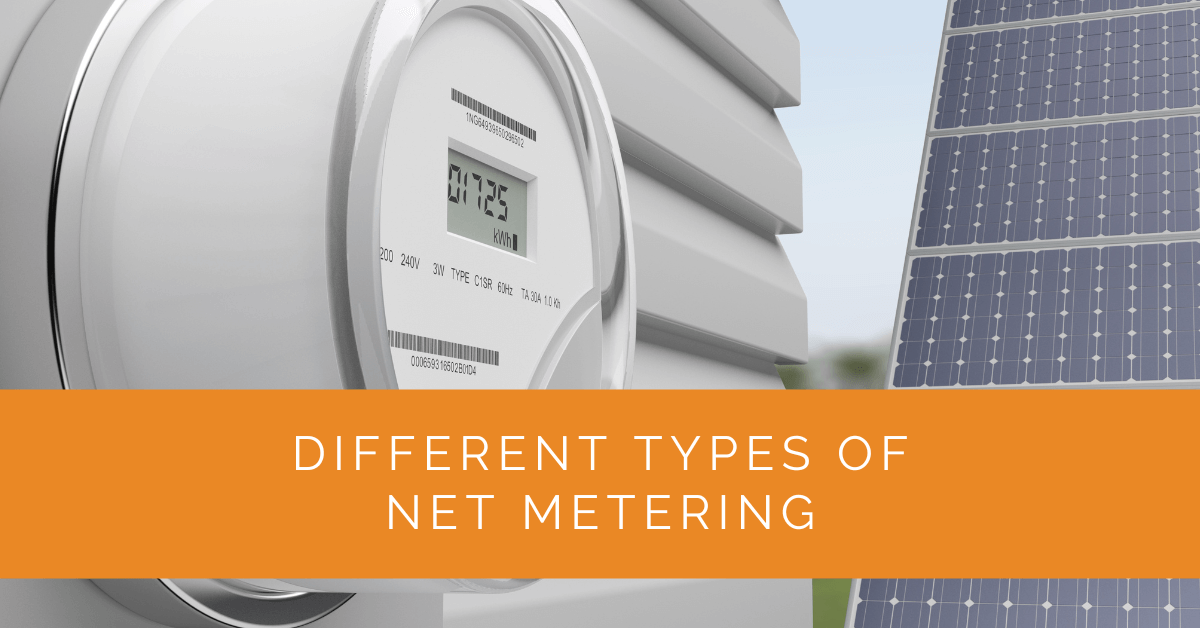The world of solar energy is evolving rapidly, and net metering is one of the key components that has revolutionized how we harness solar power. Net metering allows solar panel owners to generate clean, renewable energy and save money on their electricity bills. In this comprehensive guide, we’ll delve into the intricacies of different types of net metering, how they work, and the myriad benefits they offer solar system owners.
Contents
- 1 Key Takeaways
- 2 Net Metering Basics
- 3 Types of Net Metering
- 4 Net Metering Savings Calculator
- 5 Benefits of Net Metering
- 6 Case Study: Exploring Different Types of Net Metering
- 7 Expert Insights From Our Solar Panel Installers About Different Types of Net Metering
- 8 Experience Solar Excellence with Us!
- 9 Conclusion
Key Takeaways
- Net metering allows solar panel owners to generate clean energy, reduce electricity bills, and contribute to a more sustainable future by returning surplus power to the grid.
- Different types of net metering, including traditional, virtual, and time-of-use net metering, offer various benefits and options for solar system owners and communities.
- Net metering reduces your carbon footprint and provides financial savings and a return on investment, making it a valuable component of the transition to renewable energy sources.
Net Metering Basics
How Does Net Metering Work?
Net metering is a billing arrangement with your utility company that allows you to return excess solar electricity to the grid. When your solar panels generate more electricity than your home uses, the surplus energy is sent back to the grid, and you receive credits on your utility bill. These credits can offset the electricity you pull from the grid when your solar panels aren’t generating electricity, such as at night.
This process turns your home into a mini-power station, as any surplus electricity you generate is fed back into the grid for others to use. Net metering is a win-win for both solar system owners and utility companies, as it promotes using clean energy while reducing the demand for fossil fuels.
Reducing Your Electricity Bill with Net Metering
The beauty of net metering lies in its ability to reduce your electricity bill significantly. Instead of relying solely on the energy generated by your solar panels, you can pull from the grid when needed and use the credits earned from excess solar energy to offset your utility costs. This arrangement ensures that your solar investment pays off even faster.
Imagine your solar panels generate abundant electricity on a sunny day, and your home’s energy consumption is relatively low. The surplus energy flows back into the grid, earning you credits. You can utilize those credits to cover your energy needs at night or on cloudy days when your solar panels aren’t producing electricity. This dynamic billing system ensures you reduce your reliance on the grid and maximize your savings.
The Role of a Bi-Directional Meter
To make net metering work, a bi-directional meter is essential. Unlike a traditional meter that only measures the electricity you pull from the grid, a bi-directional meter tracks the electricity you pull from the grid and the surplus electricity you send back to it. This ensures accurate billing and credit calculations.
A bi-directional meter is a critical component of the net metering system, as it allows for the seamless exchange of electricity between your home and the grid. When your solar panels generate surplus electricity, the meter records this excess and credits your account accordingly. Conversely, the meter accurately measures your consumption when pulling electricity from the grid. This bidirectional energy flow ensures you’re fairly compensated for the clean energy you contribute to the grid.

Types of Net Metering
Traditional Net Metering
Traditional net metering is the most common type in the solar industry. Under this arrangement, any excess electricity your solar panels generate is sent back to the grid in exchange for credits on your bill. You can then use these credits when you need to pull electricity from the grid, such as at night or on cloudy days.
The beauty of traditional net metering lies in its simplicity. When your solar panels produce more energy than your home consumes, the surplus automatically flows back into the grid. This surplus energy is measured by your bi-directional meter, and you’re credited for it. When you need electricity from the grid, such as when your solar panels are inactive, you can use these credits to offset your consumption.
Virtual Net Metering
Virtual net metering is a game-changer for those who cannot install solar panels on their property, such as renters or residents of multi-unit buildings. In this system, the credits earned from a shared solar installation, often off-site, are allocated to multiple participants. This allows individuals to benefit from solar energy without needing a solar installation on their property.
Virtual net metering opens the door to solar energy for various individuals and communities. Imagine living in an apartment complex or a condominium where installing solar panels on your rooftop is not feasible. With virtual net metering, you can still enjoy the benefits of solar energy by receiving credits for the electricity generated by a shared solar installation elsewhere. It’s a win-win for solar enthusiasts and property owners, as it promotes renewable energy adoption without needing on-site solar installations.
Time-of-Use (TOU) Net Metering
Some regions offer time-of-use net metering, where electricity prices vary daily. Under TOU net metering, you earn different credits depending on when you send excess energy to the grid. You can maximize your savings and minimize electricity costs by strategically using and storing your surplus energy.
Time-of-use net metering encourages energy consumption during off-peak hours when electricity rates are lower. You receive higher credits when your solar panels generate surplus energy during these periods. You can optimize your net metering benefits by aligning your energy consumption with the TOU pricing structure. This approach saves money and contributes to the grid’s stability by reducing peak demand.
Net Metering for Solar Installers
Solar installers are crucial in ensuring that net metering benefits solar system owners. They are responsible for integrating solar panels with the grid, ensuring compliance with local net metering policies, and helping customers navigate the complexities of net billing and net metering credits.
Solar installers are the experts who make your solar dreams a reality. They assess your property’s solar potential, design the solar energy system, obtain the necessary permits, install the solar panels, and ensure that everything is seamlessly connected to the grid. In addition to the technical aspects, solar installers also guide you through the paperwork, ensuring you receive the full net metering benefits.
Net Metering Savings Calculator
Estimate your yearly savings under different net metering programs.

Benefits of Net Metering
Reducing Your Carbon Footprint
One of the most significant advantages of net metering is its contribution to reducing your carbon footprint. By generating your clean solar energy and sending surplus energy to the grid, you reduce the reliance on fossil fuels for electricity generation.
The environmental impact of net metering is profound. When your solar panels generate clean energy, you’re reducing your carbon emissions and displacing the need for electricity generated from coal, natural gas, or other fossil fuels. This shift toward cleaner energy sources is essential for combating climate change and preserving our planet for future generations.
Financial Savings and Return on Investment (ROI)
Net metering helps you save money on your electricity bill and offers an excellent return on your solar investment. In some cases, solar system owners can even generate surplus credits that can be monetized, further enhancing the financial benefits.
The financial benefits of net metering extend far beyond reduced electricity bills. When you invest in a solar energy system, you’re essentially locking in your electricity costs for decades. Unlike utility rates that can fluctuate unpredictably, your solar panels provide a stable source of energy that continues to generate savings year after year.
Furthermore, in some regions, you can sell surplus credits back to the utility at the retail rate, allowing you to monetize your surplus electricity production. This boosts your return on investment and demonstrates the economic viability of renewable energy systems. Net metering empowers individuals and communities to take control of their energy consumption, reduce costs, and actively participate in the transition toward a sustainable energy landscape.
Case Study: Exploring Different Types of Net Metering
Background
At Solar Panels Network USA, we are dedicated to providing innovative solar solutions that maximize the benefits of renewable energy. This case study examines our implementation of various net metering types to showcase their advantages and practical applications for different customer needs.
Project Overview
Our project aimed to demonstrate the benefits of traditional, virtual, and time-of-use net metering through real-world installations. By working with diverse clients, we showcased how each net metering type can optimize solar energy usage and financial returns.
Implementation
- Traditional Net Metering: We installed traditional net metering systems for residential clients with ample roof space for solar panels. These systems allowed homeowners to send excess energy back to the grid in exchange for credits, which they used to offset their electricity bills when solar production was low.
- Virtual Net Metering: For clients living in multi-unit buildings or those unable to install solar panels on their properties, we implemented virtual net metering. By participating in shared solar installations, these clients received credits for their portion of the generated energy, making solar benefits accessible without on-site installations.
- Time-of-Use (TOU) Net Metering: In regions with time-of-use pricing, we set up TOU net metering systems. These systems tracked energy production and consumption based on varying electricity rates throughout the day. Clients were advised on optimizing their energy usage during off-peak hours to maximize savings.
Results
Economic Benefits
- Traditional Net Metering: Homeowners experienced a significant reduction in their electricity bills. The ability to earn and use credits for surplus energy ensured that their solar investment provided quick returns.
- Virtual Net Metering: Renters and multi-unit residents enjoyed the financial benefits of solar energy without the need for personal installations. Shared solar credits made it possible for them to reduce their utility costs substantially.
- Time-of-Use Net Metering: Clients with TOU systems saw impressive savings by aligning their energy consumption with lower-rate periods. This strategic approach maximized their financial returns from solar energy.
Environmental Impact
- Traditional Net Metering: By generating and using clean energy, homeowners reduced their reliance on fossil fuels and decreased their carbon footprint.
- Virtual Net Metering: Communities benefited from increased renewable energy adoption, contributing to a greener environment without individual installations.
- Time-of-Use Net Metering: Clients helped stabilize the grid by reducing demand during peak hours, further promoting the use of renewable energy sources.
Community Impact
- Traditional Net Metering: Increased awareness and adoption of solar energy among homeowners inspired neighbors to consider similar installations.
- Virtual Net Metering: Provided an inclusive approach to solar energy, ensuring that more people could participate in the transition to renewable energy.
- Time-of-Use Net Metering: Educated clients on the benefits of strategic energy consumption, fostering a community-wide effort to reduce energy costs and environmental impact.
Summary
Our project effectively demonstrated the diverse benefits of different net metering types. Traditional net metering provided straightforward savings for homeowners, virtual net metering made solar accessible to renters and multi-unit residents, and time-of-use net metering offered strategic financial advantages. Solar Panels Network USA successfully showcased how tailored net metering solutions can meet various customer needs, promoting renewable energy adoption and maximizing financial returns.
Expert Insights From Our Solar Panel Installers About Different Types of Net Metering
Traditional net metering is straightforward and effective. It allows homeowners to maximize their solar investment by earning credits for the excess energy they produce.
Senior Solar Installer
Virtual net metering opens up solar benefits to people who can’t install panels on their property. It’s a game-changer for renters and those in multi-unit buildings.
Lead Solar Engineer
Time-of-use net metering requires strategic planning but can significantly increase savings. Aligning energy consumption with lower rates makes a substantial difference.
Solar Energy Consultant
Experience Solar Excellence with Us!
Trust in Solar Panels Network USA, where our seasoned experts deliver top-quality solar solutions for homes and businesses nationwide. With a legacy of countless successful installations and a commitment to sustainable energy, we’re your reliable partner in the solar journey. Ready for a brighter, eco-friendly future? Call us now at (855) 427-0058 and harness the power of the sun!
Conclusion
Understanding the various types of net metering is essential for anyone considering a solar energy system. Whether you opt for traditional net metering, explore virtual net metering options, or take advantage of time-of-use net metering, the benefits are clear. Net metering empowers solar system owners to harness the full potential of their solar panels, reduce their electricity bills, and contribute to a more sustainable future powered by renewable energy.
If you’re ready to go solar, it’s crucial to consult with a reputable solar installer who can guide you through the process, ensure compliance with net metering policies, and help you make the most of this innovative energy solution. Embrace the sun’s power, reduce your reliance on the grid, and enjoy the numerous benefits of net metering.
By exploring the different types of net metering and leveraging the sun’s abundant energy, you can take charge of your energy use, save on your electricity bill, and positively impact the environment – all while enjoying the convenience of a solar-powered lifestyle. Don’t miss out on the opportunity to go solar and join the community of solar system owners shaping the future of renewable energy.
About the Author
Solar Panels Network USA stands at the forefront of solar energy solutions, driven by a team of seasoned solar engineers and energy consultants. With over decades of experience in delivering high-quality solar installations and maintenance, we are committed to promoting sustainable energy through customer-centric, tailored solutions. Our articles reflect this commitment, crafted collaboratively by experts to provide accurate, up-to-date insights into solar technology, ensuring our readers are well-informed and empowered in their solar energy decisions.

